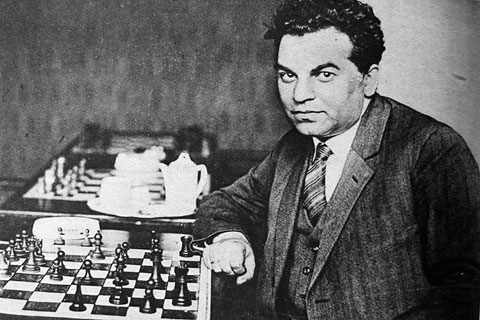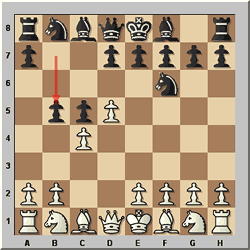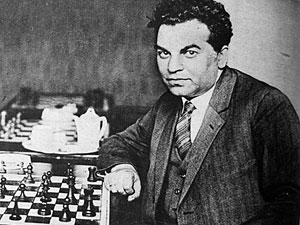GM Richard Reti’s endgames
By Pál Benkö
It is time to celebrate Richard Réti's upcoming 125th birthday! He was born in 1889 in Hungary (now Slovakia). He achieved outstanding performances besides competitive chess. He held the world record in blindfold chess, then with 29 boards simultaneously. He brought new modern ideas in opening theory too, and he presented them not only in his own games but also with his publications. He was also a famous endgame author, and I now wish to present some of his works.

Stalemate? Mate!

[Event "Bohemia"] [Site "?"] [Date "1923.??.??"] [Round "?"] [White "Reti, Richard"] [Black "White to play and win"] [Result "1-0"] [SetUp "1"] [FEN "8/8/8/8/5p2/R6B/1K2p3/3k4 w - - 0 1"] [PlyCount "7"] [EventDate "1923.??.??"] {The intention is} 1. Rd3+ ({But there is also a game-like solution:} 1. Bg4 $1 Kd2 2. Bxe2 Kxe2 3. Kc1 $1 f3 4. Ra2+ Ke1 (4... Ke3 5. Kd1) (4... Kf1 5. Kd2) 5. Ra8 f2 6. Re8+ {wins.}) 1... Ke1 2. Rf3 Kd2 (2... Kd1 3. Bg4 e1=Q 4. Rd3#) 3. Bf1 $1 e1=Q (3... exf1=Q 4. Rxf1 Ke3 5. Kc2 f3 6. Re1+) 4. Rd3# 1-0
If we put the a3 rook to g3 as a start it would eliminate the double solution but such a start does not look aesthetic. Here is the refined version:

[Event "Correction"] [Site "?"] [Date "2014.??.??"] [Round "?"] [White "Reti/Benko, Richard/Pal"] [Black "White to play and win"] [Result "1-0"] [SetUp "1"] [FEN "8/8/8/5p2/8/1K3R1B/4p3/4k3 w - - 0 1"] [PlyCount "7"] 1. Kc2 $1 f4 2. Kb2 $1 (2. Kd3 $2 Kd1 3. Bg4 e1=N+ $1 $11) 2... Kd2 (2... Kd1 3. Bg4 e1=Q 4. Rd3#) 3. Bf1 e1=Q 4. Rd3# 1-0
Double Defect

[Event "Denken und Raten"] [Site "?"] [Date "1928.??.??"] [Round "?"] [White "Reti, Richard"] [Black "White to play and win"] [Result "1-0"] [SetUp "1"] [FEN "8/1p1N4/8/4P3/1K6/1P2k3/8/1r6 w - - 0 1"] [PlyCount "11"] [EventDate "1928.??.??"] 1. e6 Kd4 ({Or} 1... Kf4 2. e7 Re1 3. Nf6 Rxe7 4. Nd5+ {winning.}) ({But A. Cheron cooked it with} 1... Kf2 $1 2. Ne5 Rg1 3. e7 Rg8 4. Kc5 Re8 5. Ng6 Ke3 6. b4 Ke4 $1 7. Kd6 Kd4 $1 8. b5 Kc4 9. b6 Kb5 10. Kc7 Ka6 {draw.}) 2. Ne5 Rh1 (2... Ra1 3. e7 Ra8 4. Nf7 Re8 5. Nd6 Rxe7 6. Nf5+) 3. e7 Rh8 4. Nf7 Re8 5. Nd6 Rxe7 6. Nf5+ {wins.} 1-0
The well-known cook finder André Chéron move the b3 pawn to b2 and placed the king on b3 as a refinement, but it too proves to be false:

[Event "Denken und Raten"] [Site "?"] [Date "1928.??.??"] [Round "?"] [White "Reti/Cheron, Richard/Andre"] [Black "White to play and win?"] [Result "1-0"] [SetUp "1"] [FEN "8/1p1N4/8/4P3/8/1K2k3/1P6/1r6 w - - 0 1"] [PlyCount "9"] [EventDate "1928.??.??"] 1. e6 Kd2 $1 2. Ne5 Ra1 $2 ({But:} 2... Rh1 $1 3. e7 Rh3+ $1 4. Kb4 Rh8 5. Kc5 Kc2 6. b4 Re8 7. Kd6 Kb3 {draws.}) 3. e7 Ra8 4. Nc4+ Kd3 5. Nd6 1-0
My own version of the Reti idea will hopefully remains correct and final:

[Event "Correction"] [Site "?"] [Date "2014.??.??"] [Round "?"] [White "Reti/Benko, Richard/Pal"] [Black "White to play and win"] [Result "1-0"] [SetUp "1"] [FEN "8/3N4/p7/4P3/8/1K2k3/1P6/r7 w - - 0 1"] [PlyCount "13"] 1. e6 Kd2 2. Ne5 Rh1 3. e7 Rh3+ 4. Ka2 Rh8 5. Nc4+ Kc2 6. Nd6 Rh5 7. b4 1-0
The solution of other lines are just as given at the original work. The centralised knight dominates the board.
The Reti manoeuvre
At first sight it is hard to believe that this is a draw. The solution contains peculiar king moves.

[Event "Deutsch Österreichische Tageszeitung (m"] [Site "?"] [Date "1921.09.11"] [Round "?"] [White "Reti, Richard"] [Black "White to play and draw"] [Result "1/2-1/2"] [SetUp "1"] [FEN "8/6p1/k1P2p1p/7K/8/8/8/8 w - - 0 1"] [PlyCount "11"] [EventDate "1921.??.??"] 1. Kg6 $1 f5 (1... Kb6 2. Kxg7 $1 h5 (2... f5 3. Kf6 f4 4. Ke5 f3 5. Kd6) 3. Kxf6 h4 4. Ke5 $1 Kxc6 (4... h3 5. Kd6 h2 6. c7 Kb7 7. Kd7) 5. Kf4) (1... h5 2. Kxg7 h4 3. Kxf6 Kb6 4. Ke5 Kxc6 5. Kf4) 2. Kxg7 f4 (2... Kb6 3. Kf6 f4 4. Ke5 f3 5. Kd6 $11) 3. Kf6 f3 4. Ke7 f2 5. c7 f1=Q 6. c8=Q+ 1/2-1/2
Spectacular

[Event "Hastings and St. Leonards Post"] [Site "?"] [Date "1922.??.??"] [Round "?"] [White "Reti, Richard"] [Black "White to play and win"] [Result "1-0"] [SetUp "1"] [FEN "8/8/2k4b/P7/8/8/2N2PKp/8 w - - 0 1"] [PlyCount "3"] [EventDate "1922.??.??"] 1. Nd4+ Kc5 (1... Kb7 2. Kxh2 Ka6 3. Nb3 Bf4+ 4. Kh3 Kb5 5. Kg4 Bb8 6. f4 Kb4 7. f5 {wins.}) 2. Kh1 $1 {Zugzwang: the bishop is lost, wherever it moves. It is a short study, but the last move is quite incredible.} 1-0
Reti started composing endgames only during the twenties (about 60 pieces of work). During that time he lived in Vienna and in Prague. He still played in the first Chess Olympiad in London 1927 for the Czechoslovak team and he made the best score on the board one. He died at a young age in Prague in 1929. Yet he still alive in his works.
The Benko Gambit
1.d4 Nf6 2.c4 c5 3.d5 b5

In The Benko Gambit by P. Benko (New York, 1973) the author wrote: ‘It is hardly possible to state precisely who first adopted the gambit. Some Swedish sources mention that it first occurred there in the 1920s and that tournaments especially for the gambit were organized later. The three internationally known masters of Sweden’s past – Ståhlberg, Stoltz and Lundin – also used it, although Ståhlberg found it not to his taste either as White or as Black. Indeed, the Swedish players appear to have used the king’s-side fianchetto, if not the modern order of moves. Of course, the gambit may have occurred elsewhere as well, but it was undoubtedly Lundin who introduced it into international tournament practice. Nevertheless, it later fell into oblivion.' |
|
Some earlier ChessBase articles on Pal Benko
3/26/2014 – Pal Benko on Richard Réti’s endgames (1)
At the turn of the last century an Austro-Hungarian mathematician shook up the chess world with revolutionary new ideas ("hypermodernism"), and with some of the most original endgame studies ever devised. To celebrate his upcoming 125th birthday another great chessplayer and endgame specialist, GM Pal Benko, has sent us some examples of Reti's works.
12/23/2013 – Pal Benko: Secrets of Study Composition (2)
One of the greatest study composers – as well as a former world championship candidate – is our friend Pal Benko, who never fails to send us a special Christmas gift. This year it was an article that offers unique insight into the process of chess composition. We brought you the first part a week ago. Today it is about breaking the pin and avoiding stalemate. And there is a remarkable study for you to solve.
12/17/2013 – Pal Benko: Secrets of Study Composition (1)
There is more to chess than tournament games. The area of chess studies and problems is equally creative and breathtakingly imaginative. One of its greatest composers is grandmaster (and world championship candidate 1959 + 1962) Pal Benko. The 85-year-old author of some of the most famous studies of all time has sent us an essay on the remarkable process of chess composition.
7/15/2013 – The Life Gambit à la Benko
Pal Benko (Hungarian: Benkö Pál) is, as 99% of our readers probably know, a legendary chess grandmaster, author, and composer of endgame studies and problems. He was born on July 15 1928, which made him 85 today. Diana Mihajlova met the fit and active octogenarian, who has been a "pal" of our company for a decade, in his home town of Budapest. Here is part one of her birthday report.
7/18/2013 – The Life Gambit à la Benko – Part two
On Monday Pal Benko, legendary grandmaster, author, and problem composer, turned 85. Diana Mihajlova, who recently met with the fit and active octogenarian in his home town of Budapest, sent us a birthday report in two parts. Today we learn of Benkos escape from Communist Hungary to the US, and his relationship with Bobby Fischer. And we get to solve two highly entertaining problems.
5/20/2011 – Greetings from Pál Benkö for 25 years of ChessBase
"Congratulations to ChessBase on your 25th anniversary! Your news page is the the first thing I look at every day when I go on the Internet. You do such wonderful work. Keep up your great service for the whole chess world." Heartening words from legendary great chess player, theorist, author and problem composer – who in addition sent six anniversary puzzles for our readers.
4/24/2011 – Easter puzzles by Benko – a World Champion challenge
Pál Benkö, 82 and still going strong, is a world class grandmaster, author and problem composer. He is also a faithful friend who periodically sends us puzzles for our newspage. This time, for Easter, he has selected four problems which stumped a World Champion. It is a challenge for you to do better, and win a special prize in the process. Enjoy.
12/30/2009 – Pal Benko improves on Troitzky
In 1856 the great Sam Loyd composed a chess problem, which 75 years later inspired Alexey Troitsky, one of the greatest composers of endgame studies, to create a puzzle with a similar theme. It proved to be flawed. 75 years after Troitzky another great composer, Pal Benko, took up his problem, improved on it and submitted it for our Christmas Puzzle page.



























